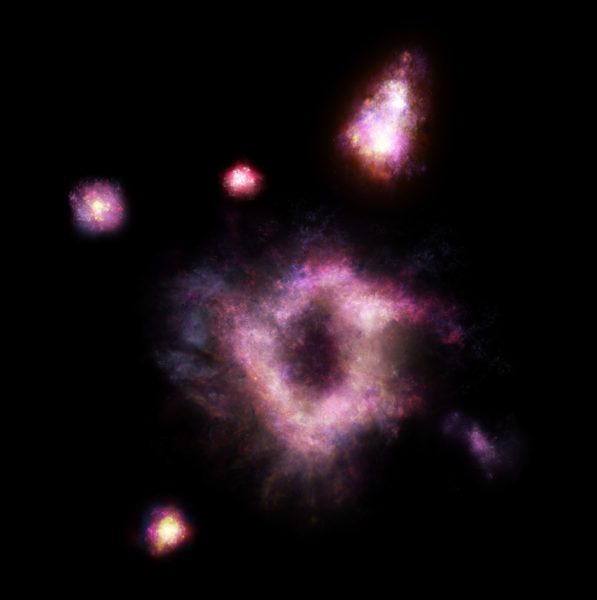Astronomers find rare galaxy from 11 billion years ago
TORONTO, May 25, 2020 – Researchers have found a rare and massive collisional ring galaxy from some 10.8 billion years ago that is forming stars 50 times faster than the Milky Way, says York University Postdoctoral Fellow Leo Alcorn of the Faculty of Science.
These kinds of ring galaxies are formed when one galaxy collides with another galaxy that passes through its centre.
“The aftermath of the collision leaves behind a ring of diffuse light around the galaxy, a density wave of stellar material,” says Alcorn, a co-author on the paper, “A giant galaxy in the young Universe with a massive ring,” published today in Nature Astronomy.

An artist’s impression of the ring galaxy. Credit: James Josephides, Swinburne Astronomy Productions
She adds that “this collisional ring galaxy is believed to be the most distant collisional ring confirmed to date.”
The discovery could shake up theories about the earliest formation of galactic structures and how they evolve.
Little is known about distant collisional rings, but with this finding the research team, led by researcher Tiantian Yuan of Australia’s ARC Centre of Excellence for All Sky Astrophysics in 3 Dimensions, can provide what it believes is the first detailed study of a ring galaxy from 10.8 billion years ago.
“It is a very curious object that we’ve never seen before,” says Yuan, who is based at the Centre for Astrophysics and Supercomputing at Swinburne University of Technology. “Most of that activity is taking place on its ring – so it truly is a ring of fire.”
The researchers found the massive collision ring galaxy, named R5519, while searching for spiral galaxies.
“These systems are rare in the local Universe but finding one at a lookback time of 10.8 billion years ago, is unexpected,” says Alcorn. “We were not expecting to see a system like this so long ago given the rarity of these events in the local Universe.
An artist’s impression of how the ring galaxy formed. Credit: James Josephides, Swinburne Astronomy Productions
She says the importance of this finding is it will allow researchers to study significantly more about merger-driven star formation and how disk galaxies evolve and interact with their environment, as well as with neighbouring galaxies.
This galaxy is similar in stellar mass to the Milky Way, but more than one and a half times larger in stellar half-light radius. It also has a clear ring structure and large diffuse disk, resembling a giant donut. It may be the most distant collisional ring confirmed to date. The closest thing to it in the local Universe is the well-known Cartwheel Galaxy, also a collisional ring galaxy.
The hole at its centre is three million times bigger than the diameter of the supermassive black hole in the galaxy Messier 87, which in 2019 became the first ever to be directly imaged.
The team worked with colleagues from Australia, the United States, Canada, Belgium and Denmark. Spectroscopic data was gathered by the WM Keck Observatory in Hawaii and images recorded by NASA’s Hubble Space Telescope to identify the unusual structure of the galaxy.
PHOTOS:
An artist’s impression of the ring galaxy https://news.yorku.ca/files/Ring-galaxy-artist-still-James-Josephides-scaled.jpg Credit: James Josephides, Swinburne Astronomy Productions
A composite image of the ring galaxy R5519 compiled from single-colour images taken by the Hubble Space Telescope https://news.yorku.ca/files/Ring-galaxy-image-1-scaled.jpg Credit: Tiantian Yuan/Hubble Space Telescope
Animated GIF: https://news.yorku.ca/files/Ring-galaxy-animated.gif Credit: James Josephides, Swinburne Astronomy Productions
Cartwheel galaxy: https://news.yorku.ca/files/Cartwheel-galaxy.-Credit-Curt-Struck-and-Philip-Appleton-Iowa-State-University-Kirk-Borne-Hughes-STX-Corporation-and-Ray-Lucas-Space-Telescope-Science-Institute-and-NASA-ESA.jpg Credit: Curt Struck and Philip Appleton (Iowa State University), Kirk Borne (Hughes STX Corporation), and Ray Lucas ( Space Telescope Science Institute), and NASA/ESA
-30-
York University champions new ways of thinking that drive teaching and research excellence. Our students receive the education they need to create big ideas that make an impact on the world. Meaningful and sometimes unexpected careers result from cross-disciplinary programming, innovative course design and diverse experiential learning opportunities. York students and graduates push limits, achieve goals and find solutions to the world’s most pressing social challenges, empowered by a strong community that opens minds. York U is an internationally recognized research university – our 11 faculties and 25 research centres have partnerships with 200+ leading universities worldwide. Located in Toronto, York is the third largest university in Canada, with a strong community of 53,000 students, 7,000 faculty and administrative staff, and more than 300,000 alumni. York U's fully bilingual Glendon Campus is home to Southern Ontario's Centre of Excellence for French Language and Bilingual Postsecondary Education.
Media Contact:
Sandra McLean, York University Media Relations, 416-272-6317, sandramc@yorku.ca

